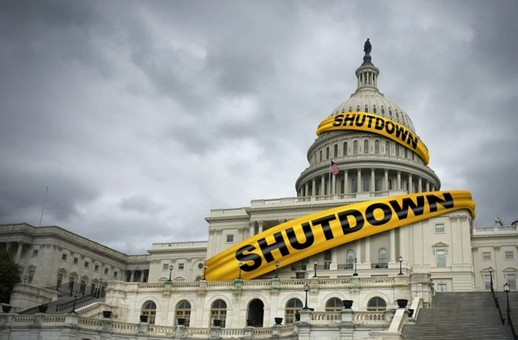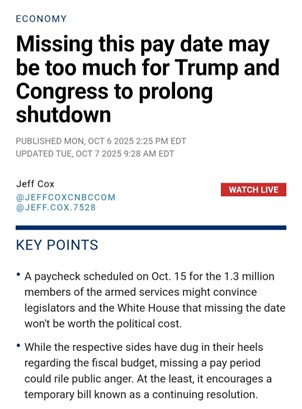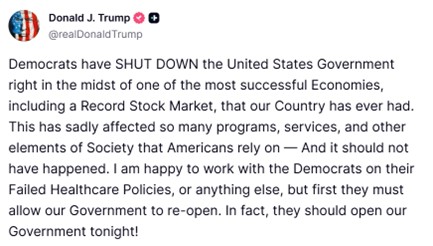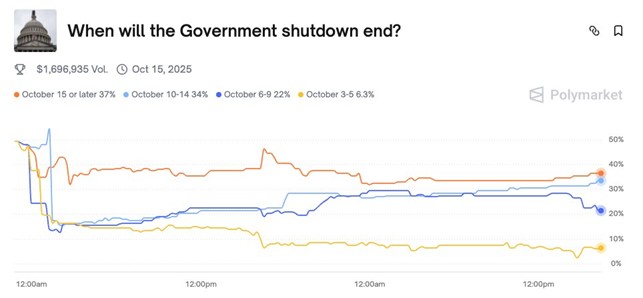Introduction
The US government shut down on October 1, 2025, after Republicans and Democrats rejected each other’s proposals in Congress on the Interim Budget (H.R. 5371).
The shutdown process was first;
llH.R. (House of Representatives) 5371, a stopgap budget bill intended to continue funding federal agencies until actual budget legislation is approved for the new U.S. fiscal year that began on October 1. Voting took place to enact the Continuing Resolution (CR) bill, which would keep the federal government running from October 1, 2025. This bill was known as H.R. 5371. The main purpose of the bill was to extend the federal government’s spending authority until November 21, 2025. This was intended to give Congress additional time to reach a permanent budget agreement. Due to the failure to reach an agreement with the Democrats on the budget, the federal government shut down for the first time in nearly 7 years.
Congress was composed of two separate chambers:
- The House of Representatives: The number of members was 435. The majority-party chamber is the starting point for the budget bill.
- Senate: 100 members (two senators from each state). Budget bills must also be approved in this chamber to become law.
In both chambers, members of the Republican Party and the Democratic Party played a key role and cast their votes during this shutdown.
In the final vote, the Republicans could not find the 60 votes needed to overcome the Democratic filibuster and the bill was rejected by 55 votes to 45. The US government is expected to remain closed for 24 days. This is the second longest government shutdown in history, surpassing the 1995 shutdown under President Clinton. It is also the first shutdown since the five-week shutdown between 2018 and 2019 during US President Donald Trump’s first term. Senate Democratic leader Chuck Schumer said his party would not give in to the Republican bill. Republican Senate Majority Leader John Thune said he would bring the stopgap budget bill to a vote repeatedly to reopen the government.
In this report, we take a detailed look at the factors that led to the US government shutdown.
What is the US Government Shutdown?
US budget spending is critical to the US economy. Under the US Constitution, the federal government needs a law approved by Congress (the budget law) to spend money.
In order for the federal government in the United States to function normally and make budgetary expenditures, it must follow two basic rules.
- The Debt Ceiling Problem
According to the US Constitution, only Congress decides how much the government can borrow.
- Initially, a separate law had to be passed by Congress for each borrowing. However, from 1917 onwards, a so-called “debt ceiling” was set to facilitate the borrowing process.
- This is the maximum amount the Treasury can borrow on behalf of the public. Once the Treasury reaches this ceiling, it cannot borrow more and has no new spending authority.
- Recent legislation has raised this debt ceiling to $41.1 trillion. Since the federal debt currently stands at around $37.5 trillion, there is no immediate problem with this ceiling for now. However, the fact that the total debt of the US has reached 30.5 trillion dollars of its GDP (30.5 trillion dollars) shows that this issue remains important in the long run.
- Failure to Approve the Budget
The regular functioning of the government requires Congressional approval of the budget before each fiscal year.
- If Congress does not approve the federal budget before the start of the new fiscal year, and in addition does not authorize a stopgap budget that would allow the government to operate for a period of time, the government would no longer have the authority to spend.
- In this case (a government shutdown) all non-essential agencies cease operations.
In the US, the federal fiscal year ends on September 30 each year. From October 1, federal agencies must be refinanced. Congress must approve and enact 12 different spending bills by October 1. When this cannot be done, a Continuing Resolution (CR) is usually passed, which allows the government to operate for a short period of time. It is precisely when this funding resolution (CR) or the 12 spending bills cannot be agreed upon that a budget dispute arises. As soon as the funding authorization expires on October 1, all non-essential federal agencies must effectively shut down. That is, political intransigence legally leads to the expiration of spending authority. Political deadlock occurs when parties use budget spending as leverage to meet their own ideological and political demands.
Possible Consequences after a Shutdown?
In the US, when the budget is not approved or a Continuing Resolution is not passed, the federal government’s spending authority ends. In other words, the state coffers are technically closed. In a statement made before the vote, White House Trump raised tensions by saying that “many federal employees could be permanently laid off” in the event of a shutdown.
As a result;
- Critical public sector employees will be able to continue working without pay, while around 750,000 federal employees will reportedly have to take unpaid leave.
- Critical functions such as police, army, health, air traffic control continue, but employees will not receive their salaries until the shutdown is over.
- Many services, from passport processing to national parks, are slowing down or stopping altogether.
- In addition, economic data (such as unemployment reports and inflation data) may not be published, leaving markets uncertain.
On the macro data front, following the government shutdown, the US Unemployment Claims to be released on October 2 and September Non-Farm Payrolls data to be released on October 3 were postponed.
There are no further votes on the calendar until mid-October. “We hope to have the government open by the FED interest rate decision on October 29,” the Senate said. Until October 29, there is a possibility of an extension. This makes the monetary policy path of the Fed, which takes into account the data announced while making interest rate decisions, uncertain. In the first week of the government shutdown in the US, according to the 6th vote in the Senate, both sides continue to vote on their own bill. October 10 is payday for government workers and October 15 is payday for 1.3 million soldiers. Each week of the shutdown removes about 0.1 percentage points from quarterly growth. There may be some compensation once the government reopens, but some of the losses may be permanent.
According to Trump’s statements on his X account and Truth Social, “Democrats shut down the U.S. government in the middle of one of the most successful economies our country has ever had, even in the midst of a record-breaking stock market. This has unfortunately affected many programs, services and other elements of society that Americans rely on. And it shouldn’t have happened. I’m happy to work with Democrats on Failed Health Policies or any other issue, but first they need to allow our Government to reopen. In fact, they should open our Government tonight,” he said.
Bloomberg Chief US Economist Anna Wong noted that the economic risks from the shutdown are quite high and that the permanent layoff of some federal employees, as threatened by Trump, could hinder the nascent recovery in the labor market. She predicts that the shutdown could last three weeks.
What are the previous examples and the duration of the shutdown?
The most recent shutdown started in December 2018 and ended in January 2019. Its total duration lasted 35 days. This set a record as the longest government shutdown in US history. The main reason for the shutdown was disagreements in the Senate over funding for a wall on the US-Mexico border, one of then-President Donald Trump’s most important election promises. Trump has stated that he will not sign the budget if it does not include the funding he requested for wall construction, which led to the budget dispute.
The dispute that led to the shutdown this time is over the health insurance program known as “Obamacare”, which was enacted under former Democratic President Barack Obama.
Obamacare Premium Support (Subsidies): Democrats want these subsidies, which help millions of low- and middle-income Americans pay insurance premiums, to continue and be guaranteed in the budget bill. These funds are the foundation of the law and if cut, millions could lose their insurance.
Rolling Back Medicaid Cuts: Democrats also want to roll back potential or planned cuts to the Medicaid program, which provides health care to low-income people in states.
Democrat senators blocked a stopgap budget bill in the Senate, a political maneuver that led to the government shutdown, because their demands for funding for these health spending and programs were not met. The Democrats demanded that the Republicans in power provide the financial resources to secure the continuation of Obamacare. Democrats demanded a rollback of cuts to Medicaid, which provides health care to poorer populations. When the Republicans rejected these demands, the road to a shutdown began.
Outcome
It is unclear how long the government will remain closed. A compromise needs to be reached in Congress. But both sides remain hardline. A compromise on a temporary budget is essential to end the shutdown. For that, Republicans need at least 60 of the 100 votes in the Senate. However, since the Republicans have only 53 seats in the Senate, they need 7 votes from the Democrats.
The majority of market participants think that the political impasse will last beyond the first two weeks and that more time will be needed to resolve the crisis. Since October 15 is usually the critical date when military personnel and other critical workers will not receive their first paycheck, expectations are high that political pressure will increase after that date. Democrats are caught between their constituents and their political goals. Democrats are trying to get answers from the Trump administration on health policy. On the other hand, many Democratic voters want a compromise. High interest rates, slow growth, harsh political atmosphere, and the daily cost of the shutdown reaching approximately $400 million continue to harm the US economy. If a compromise is reached, the shutdown can end and the perception is that the parties have reached a compromise. If a compromise is prolonged, the perception that “the US cannot be governed” is created and Treasury bond yields rise and confidence decreases. This could lead to increased volatility in the markets, pressure on the US bond market, and a reassessment by credit rating agencies of the US fiscal discipline. The fact that the bill did not pass the Senate shows that the risk still persists and will continue to put pressure on US domestic politics and global markets.









